A development roadmap is essential for startups looking to enhance their strategic planning abilities, regardless of the type of initiative or project. Today, these roadmaps play a pivotal role in steering the course of business and startup operations. Done right, a development roadmap has the potential to streamline the ability to navigate the ever-evolving landscape of tech and innovation.
At Aloa, a seasoned software outsourcing company, our team has gained top-quality insights into successfully implementing and launching complex projects using development roadmaps. In doing so, we enable strong partnerships with each client and bring a wealth of experience as a leading tech outsourcing company.
Based on our experience, we've compiled this strategic guide on development roadmaps to enhance your ability to streamline your software development initiatives. We'll go through what a development roadmap is, how to build one, and how to choose the best development roadmap template to fit your needs.
Afterward, you can apply this essential knowledge to your development process toward making a strategic plan that meets your business goals.
Let’s get started!
What is a Development Roadmap?
A development roadmap is a plan that outlines product management goals, development processes, and business objectives. It provides an overview of the product's strategic aims, the source of truth of its end users, and the development timeline. A development roadmap is a handy communication tool for the entire team.
Not only does it serve as a reference point for product owners and teams to prioritize and track the progress of product ideas but it also outlines the product strategy. It even highlights the required features and functionality while providing a timeline for development milestones.
Significance of a Development Roadmap in Startups
The development roadmap defines goals and steps for the team. It communicates the strategy, timeline, and tasks to stakeholders and the team. It also provides oversight of projects and tasks, helping the team prioritize work. With clear aims, the development roadmap enables informed decisions, effective resource allocation, and progress tracking. Additionally, it allows team members to make fast, autonomous decisions based on a better understanding of the "big picture" provided by the development roadmap.
Various Types of Development Roadmaps
Startups have different development roadmaps for product development based on their needs and goals. These roadmaps give a clear picture of how the product development process works. There are thousands of development roadmaps out there, but here are some of the top roadmaps startups use.
1. Strategy Roadmap: A Broad View
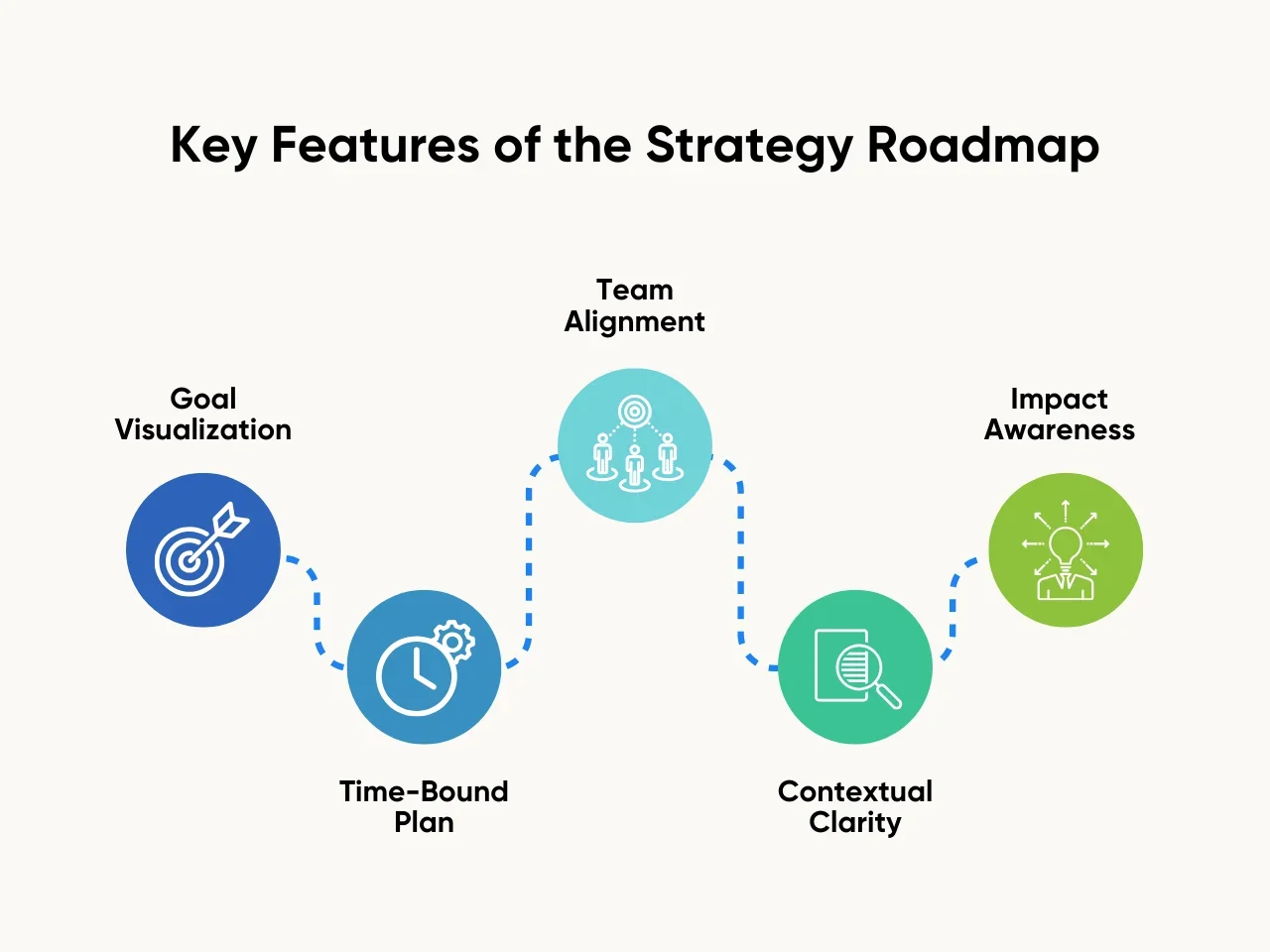
A strategy roadmap serves as a connection between strategy and execution. It illustrates the essential outcomes that must be accomplished within a specific timeframe to realize the organization's strategic vision.
Key Features of the Strategy Roadmap
- Goal Visualization: Clearly illustrates objectives.
- Time-Bound Plan: Outlines specific efforts within a defined timeframe.
- Team Alignment: Ensures all team members work towards shared objectives.
- Contextual Clarity: Links daily tasks to broader business or product goals.
- Impact Awareness: Helps teams understand how their work contributes to success.
2. Release Roadmap: A Detailed Timeline
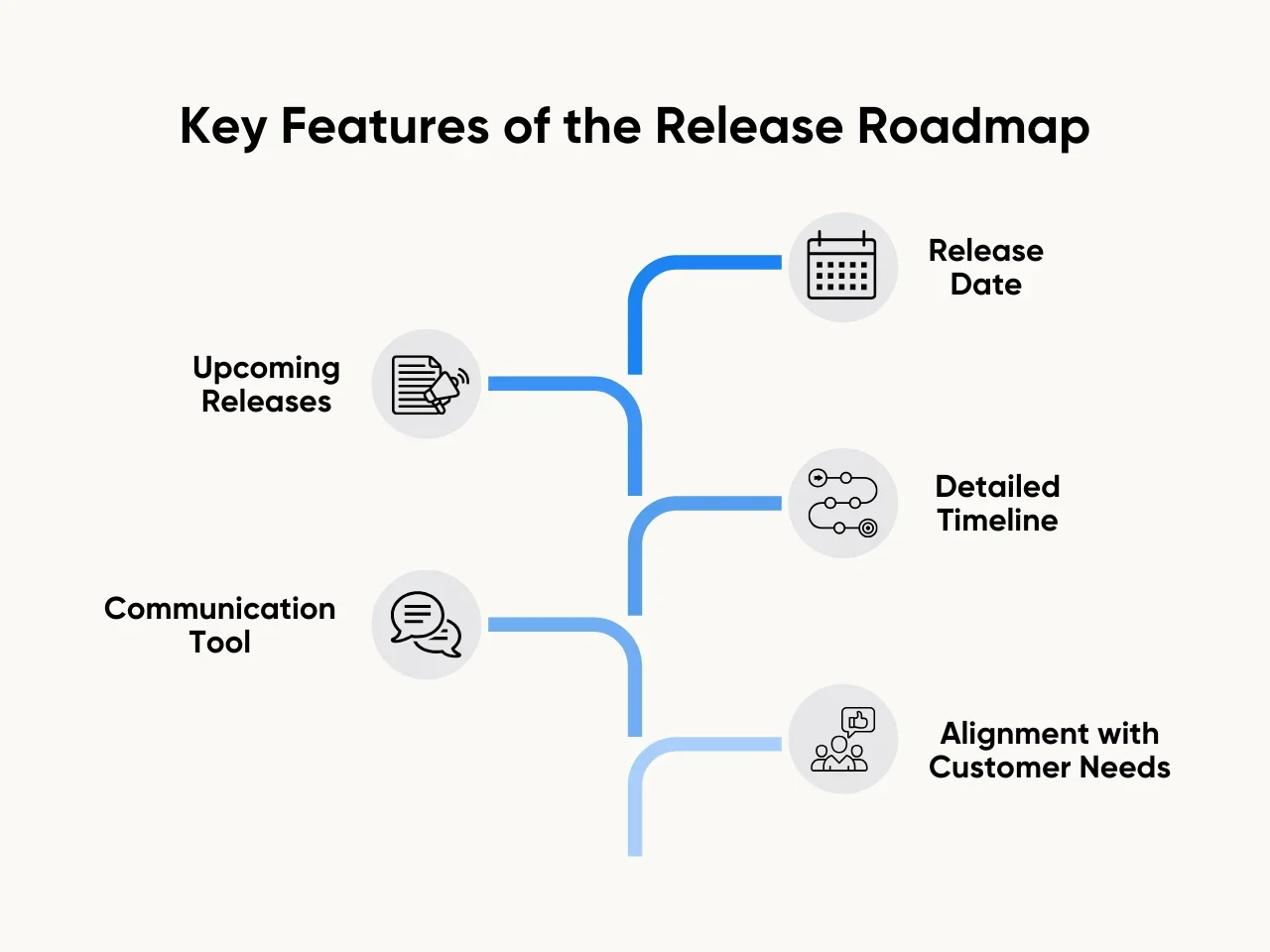
The release roadmap is a detailed timeline for upcoming software releases and features. It helps the development team plan their work, prioritize tasks, and deliver the product on time.
Key Features of the Release Roadmap
- Release Date: Specifies the release date for each software release.
- Upcoming Releases: Provides an overview of upcoming software releases and their features.
- Detailed Timeline: Includes tasks, deadlines, and dependencies for each release.
- Communication Tool: Keeps stakeholders updated on product development progress.
- Alignment with Customer Needs: Ensures that features meet customer expectations through market research and feedback.
3. Marketing Roadmap: A Customer-Centric Approach

The customer-centric marketing development roadmap focuses on digital campaign timelines, target market, and communication strategy. It aligns the development team with marketing efforts to promote the product effectively.
Key Features of the Marketing Roadmap
- Timeline of Digital Campaigns: Outlines social media, content, and email marketing activities.
- Target Market: Identifies customer segments and preferences.
- Communication Strategy: Defines key messages, channels, and tactics.
- Collaboration with Sales Teams: Aligns development and sales efforts.
- Alignment with Customer Needs: Develop solutions that resonate with the target market.
4. Technology Roadmap: A Futuristic Insight
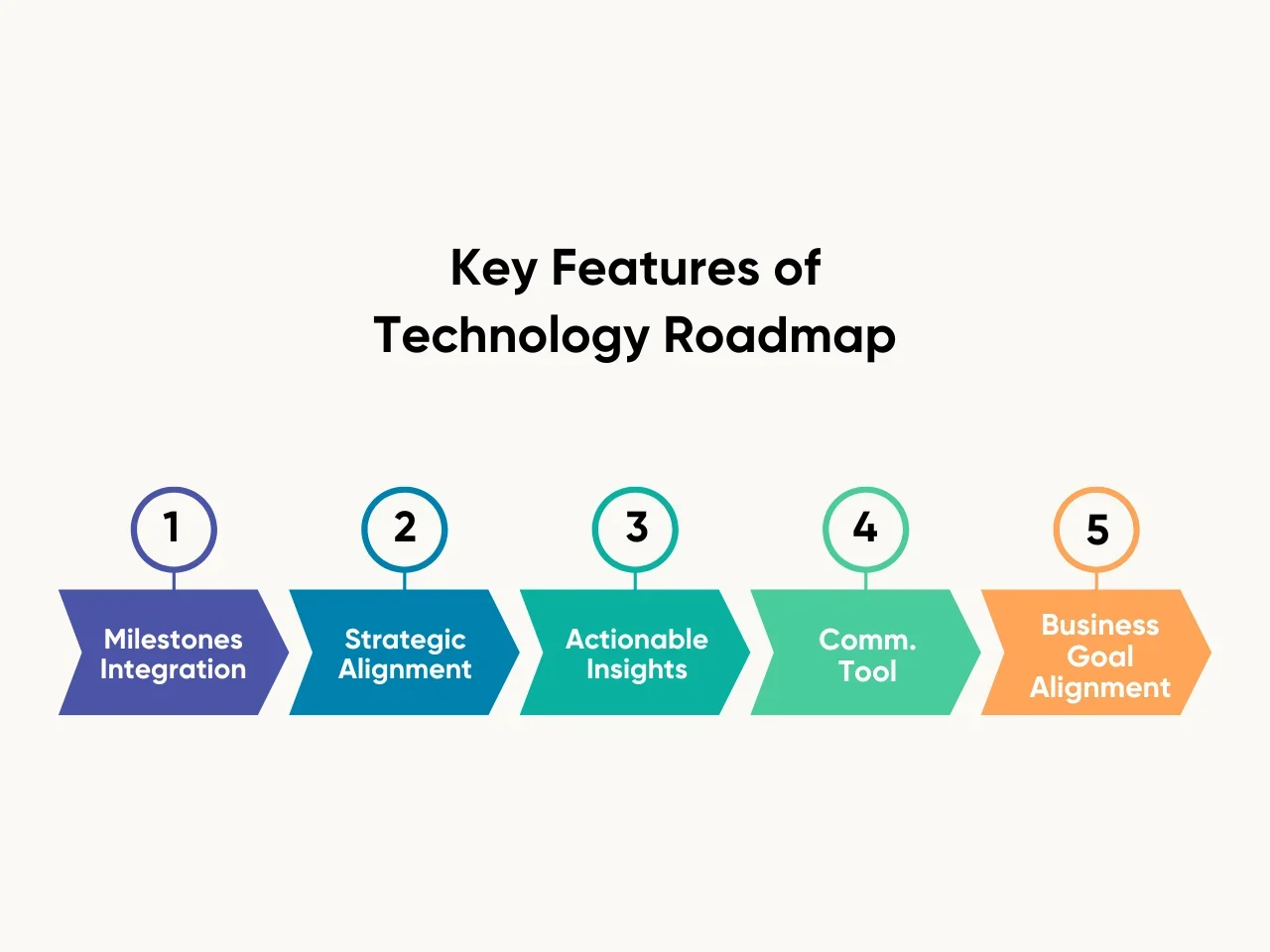
The technology roadmap provides insight into the product's technological milestones and strategy. It helps the development team plan for the future by integrating the latest advancements.
Key Features of Technology Roadmap:
- Integration of Milestones: Outlines upcoming advancements to help the team plan their work.
- Strategic Alignment: Ensures technology supports the business strategy.
- Actionable Insights: Provides informed decisions and effective task prioritization.
- Communication Tool: Updates stakeholders on progress.
- Alignment with Business Goals: Focuses on integrating technologies that support goals.
5. Portfolio Roadmap: An Overview of All Projects
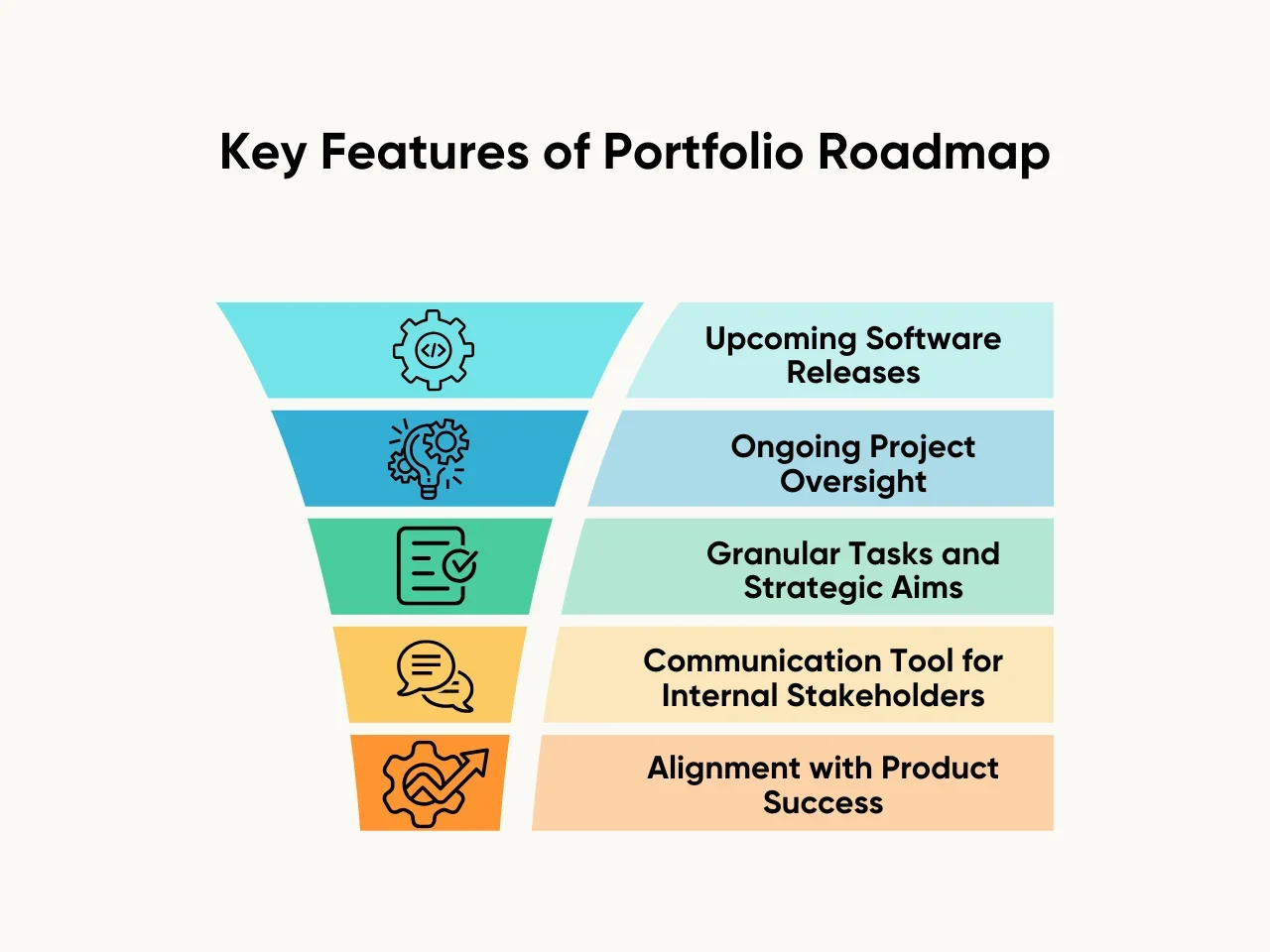
The portfolio roadmap gives an overview of projects and development efforts in the startup. It aligns with business goals and strategic aims.
Key Features of Portfolio Roadmap
- Upcoming Software Releases: Timeline and features for each release.
- Ongoing Project Oversight: Clear view of tasks, milestones, and progress.
- Granular Tasks and Strategic Aims: Focus on success-contributing tasks.
- Communication Tool for Internal Stakeholders: Visibility, feedback, and support.
- Alignment with Product Success: Projects aligned with goals and customer needs.
6. Goal-Oriented Development Roadmap
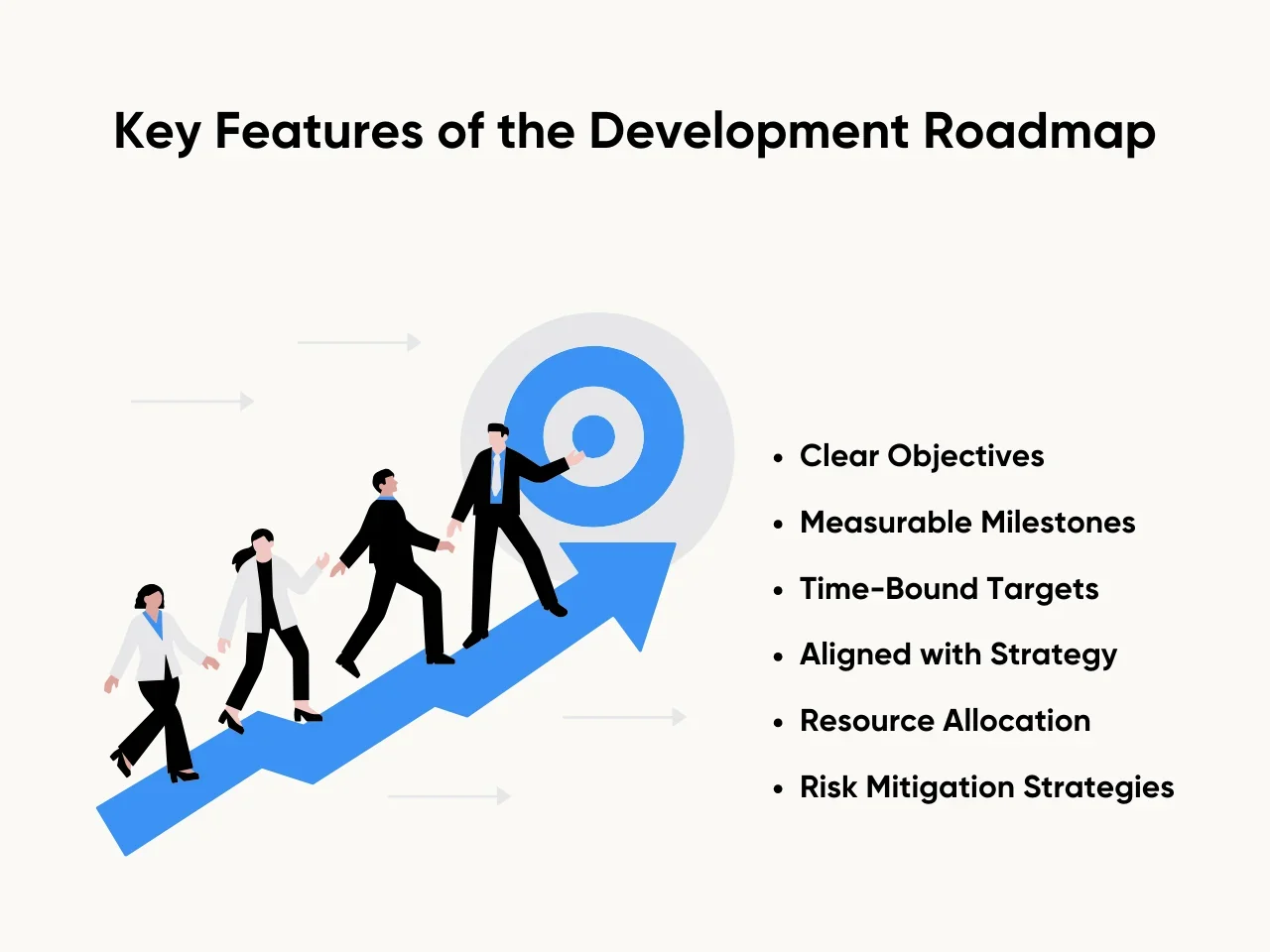
Aligning the development team’s work with end users and product success, the goal-oriented development roadmap provides oversight of ongoing projects, granular tasks, and strategic aims. It offers an overview of upcoming software releases and major technological milestones, outlining the team's overall strategy, business goals, and technology roadmap.
Key Features of the Development Roadmap
- Clear Objectives: Clearly defined and articulated goals.
- Measurable Milestones: Specific and measurable milestones.
- Time-Bound Targets: Set timelines for each goal or milestone.
- Aligned with Strategy: Integration with the broader strategic plan.
- Resource Allocation: Efficient allocation of resources to support the achievement of goals.
- Risk Mitigation Strategies: Inclusion of strategies to identify and mitigate potential risks.
Step-by-Step Guide to Building Your Development Roadmap
Now that we've covered the basics, let's delve into the details of crafting your development roadmap. We'll break down each step, providing practical ideas and guidance to ensure your roadmap is comprehensive and tailored to your project's success. Let's go through the step-by-step guide to building a practical development roadmap.
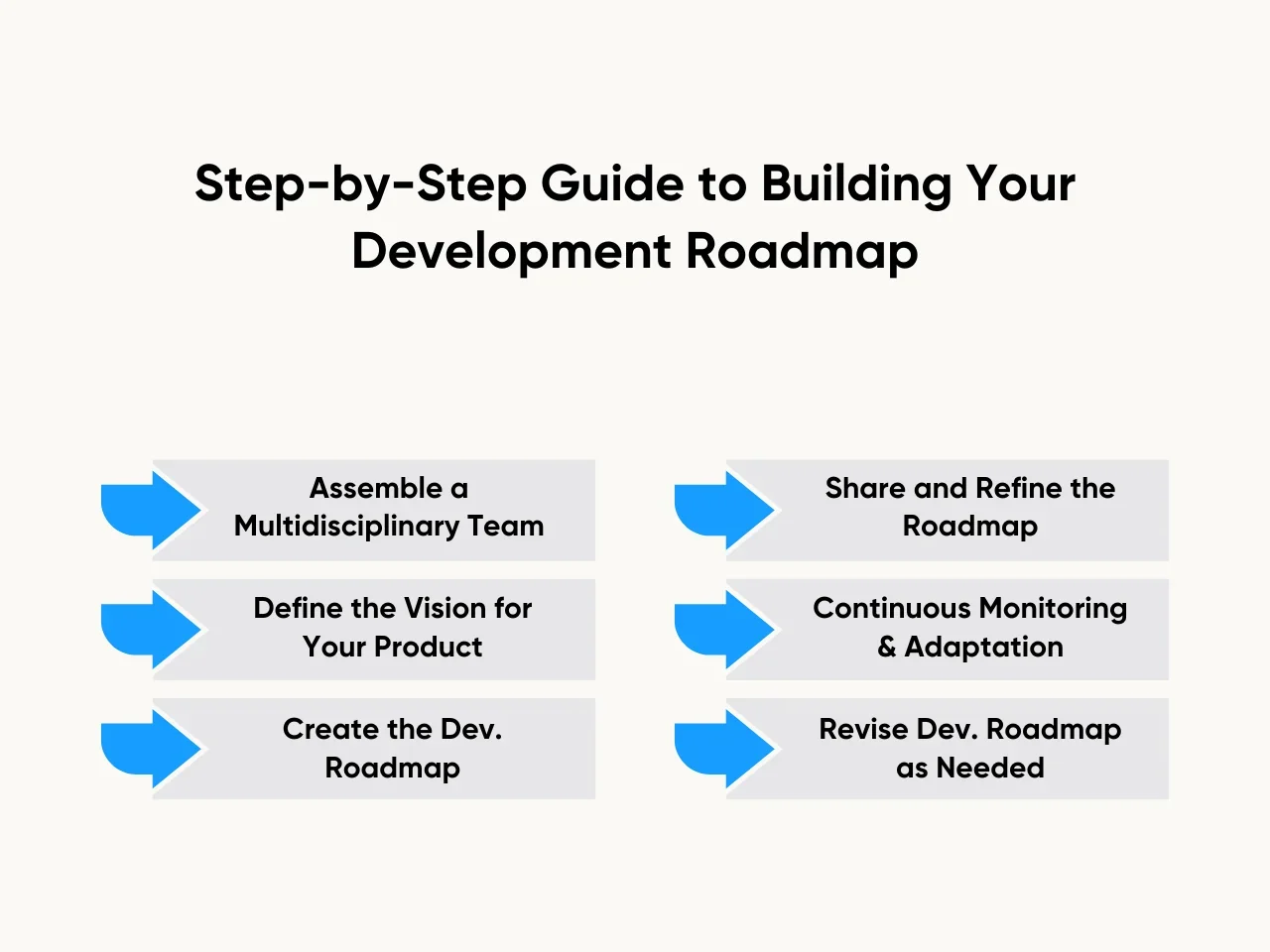
Step 1: Assemble a Multidisciplinary Team
A multidisciplinary team is a diverse group of professionals working together. Assembling a multidisciplinary team means gathering individuals with diverse skills and expertise to manage and execute the project effectively. To ensure success, emphasize collaboration, coordination, and efficient development processes. Plus, utilize development roadmaps like software development and Gantt charts. Below are some of the most used ways to assemble a team that embraces automation.
- Identify Diverse Skills: Recognize the skills needed for the project.
- Select Team Members: Choose individuals with diverse skills and expertise.
- Build Collaborative Environment: Emphasize teamwork and idea sharing.
- Coordinate Communication: Establish effective communication channels among team members.
- Implement Efficient Processes: Use streamlined development processes for effective execution.
- Utilize Roadmaps: Employ tools like Gantt charts for planning and tracking progress.
- Regular Assessment: Continuously evaluate team performance and adapt strategies accordingly.
Step 2: Define the Vision for Your Product
Clearly outline the product's vision based on concise descriptions, customer feedback, and a development timeline. The vision should cater to end users, the target market, and the development team. Involve the entire team, assign tasks, and establish release dates for new functionality. Use project management principles like Gantt charts and development roadmaps to aid this process. Below are some of the most used ways to define product vision.
- Gain Feedback and Descriptions: Collect concise descriptions and feedback from stakeholders.
- Develop Timeline: Create a timeline with milestones and deadlines.
- Involve your Team: Involve the entire team, assigning expertise-based tasks.
- Release Plans: Establish release dates using project management tools.
- Define Vision: Clearly define the product's vision catering to end users, the target market, and the team.
Step 3: Create the Development Roadmap
Develop a comprehensive development roadmap based on the product's vision and strategy involving the development team. Display the features roadmap publicly, incorporating high-level and specific features while considering development time. Map out the ideas you're committing to on your product roadmap, then break down those ideas into epics, requirements, and user stories on your delivery roadmap. Outline the next steps for the team to align with product success and business goals. Here are the critical steps to building a practical roadmap:
- Define Strategy: Outline vision, goals, and initiatives and thoroughly research buying personas, product positioning, and competitive analysis.
- Review and Assess Features: Use a scoring mechanism to evaluate potential features. Identify features that bring the most value to your initiative.
- Prioritize and Determine Requirements: Break down activities supporting your strategy into manageable units.
- Organize into Phases: Group ranked features into major releases or stages. Define the duration for each phase.
- Choose Roadmap View: Decide how to illustrate the plan over a specific time frame. Highlight key features or dependencies that influence the course of your roadmap.
Step 4: Share and Refine the Roadmap
In this crucial phase, your focus shifts towards involving key stakeholders and honing in on internal and external considerations. It's not just about presenting a plan; it's about optimizing it for the best outcomes, from strategic release dates to addressing the evolving needs of your users. You can follow the steps below to begin sharing and refining the roadmap with a strategic vision.
- Consider Other Members: Involve stakeholders, consider internal and external factors, and refine the roadmap for optimal presentation, release dates, and user needs.
- Supervise the Team: Oversee ongoing projects and product roadmap templates.
- Plan Regular Meetings: Communicate effectively with marketing and sales teams, gather feedback, and refine the roadmap.
Step 5: Establish Continuous Monitoring and Adaptation
Implement a system for continuous monitoring and adaptation of your development roadmap.
Regularly assess progress, evaluate projects and team performance, and make real-time adjustments. Incorporate checkpoints and feedback loops. By closely tracking these elements, your team can identify potential bottlenecks or deviations from the original plan. Here are the common ways to navigate this step effectively:
- Check Progress: Regularly assess the progress of ongoing projects, keeping a close eye on timelines and milestones.
- Encourage Adaptability: Stay agile in response to changes, feedback, and evolving business requirements.
- Promote Communication: Encourage open communication within the team, fostering feedback loops to refine and optimize the development roadmap as your startup grows.
Step 6: Revise Your Development Roadmap as Needed
Regularly revisit your development roadmap to accommodate changing circumstances and evolving business dynamics. These revision processes ensure that your roadmap remains a strategic and adaptable guide. Here are the common ways to establish this step efficiently:
- Regularly Check Feedback: Gather feedback from the team, stakeholders, and market insights to identify areas for improvement or modification.
- Be Receptive: Prioritize flexibility and responsiveness,
- Prioritize Adjustments: Adjust timelines, priorities, or features as soon as possible.
Finding the Perfect Development Roadmap Template
Finding the perfect development roadmap template involves understanding project management essentials, exploring different types of roadmaps, and integrating onshore software development tools. One popular method is using a Gantt chart for visualizing tasks and timelines, which is a good idea for product development roadmap planning. Each roadmap type, including waterfall, serves unique purposes, so identifying the most suitable one is crucial for successful project execution.
Templates from Smartsheet
- Templates from Smartsheet provide a concise representation of the product, incorporating customer feedback and the development timeline.
- These templates offer a comprehensive overview of the product's vision and strategic documents, aligning with high-level specific features and an ample timeline for the development process.
- Additionally, they should align with the product's success and feature roadmap, focusing on the next steps for the development team while considering project management and technology roadmap to achieve business goals.
- This ensures a streamlined approach to software development, emphasizing the utilization of Gantt charts and various types of development roadmaps.
Templates from ProductPlan
- ProductPlan's templates provide a comprehensive approach to project management and software development.
- The templates cover types of roadmaps, including the product's vision and strategy documents, to align with the business goals.
- They cater to various audiences and internal/external objectives, offering a Gantt chart for the development team's much-needed work.
- Additionally, they ensure that the public roadmap reflects the product's success and features.
- These templates are the cornerstone of a successful product development roadmap, helping to achieve the best way to meet the business goals.
Templates from Roadmunk
- Templates from Roadmunk encompass the entire team, specific tasks, and the release date of the product’s new functionality.
- The roadmap needs to consider project management, technology roadmap, and the best way to achieve the business goals.
- Catering to different audiences, internal and external objectives, and the target market’s needs, these templates align with the product’s success, the business goals, and the development team’s efforts.
- They provide an overview of upcoming software releases and major technological milestones essential for effective software development and product development roadmap.
Templates from Aha!
- Templates from Aha! offers a structured approach to visualizing product development goals, facilitating collaboration and real-time progress tracking.
- These templates are instrumental in identifying dependencies, milestones, and potential roadblocks within project management.
- With a comprehensive overview of the project's timeline and objectives, Aha! Templates prove invaluable in aligning the team around the product vision and strategy, making them an essential tool in software development.
- Using Gantt charts and various development roadmaps within these templates helps streamline the product development roadmap, ensuring a clear and strategic approach.
Templates from Trello
- Teams can customize Trello templates to suit specific features, aiding in creating a product roadmap aligned with business goals.
- Trello templates are a communication tool for product teams, sales teams, and stakeholders.
- The templates allow for developing dynamic and responsive roadmaps based on customer feedback.
- Trello templates are highly effective in the overall product development process.
- They facilitate project management and the creation of various roadmaps, including software development, Gantt charts, and product development roadmaps.
Moving Forward After Creating a Development Roadmap
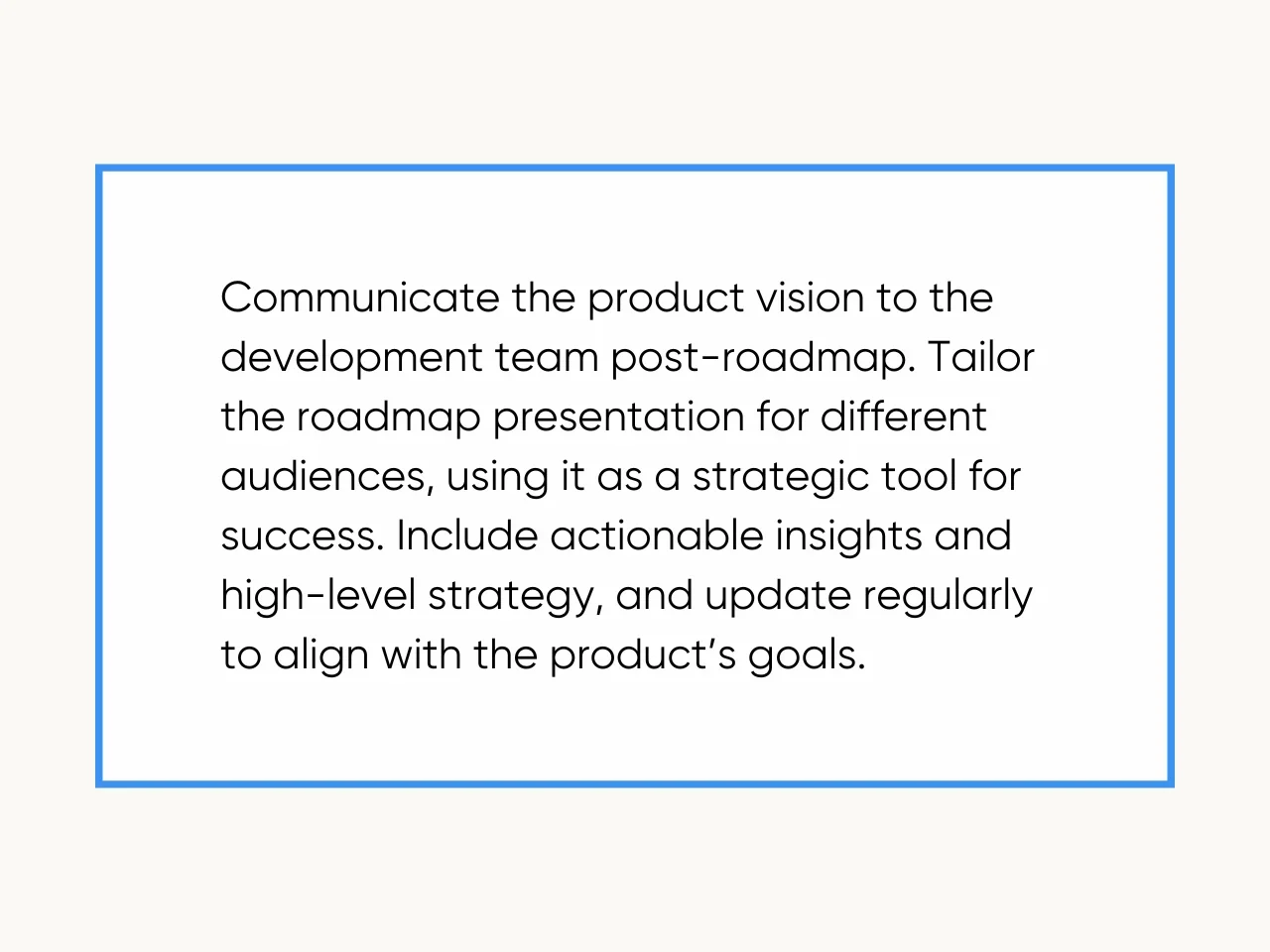
Communicating the product vision to the development team is the immediate post-roadmap step. Tailoring the development roadmap presentation to different audiences is crucial. The development team should leverage the roadmap as a strategic tool for product success.
Additionally, incorporating actionable insights and high-level strategy documents in the development roadmap is essential. Update the roadmap regularly to maintain alignment with the product’s strategic aims. Project management, various types of roadmaps, software development, Gantt charts, and product development roadmaps play crucial roles in this phase.
Key Takeaway
A development roadmap serves as the startup's cornerstone by providing a structured path that guides the creation of a Minimum Viable Product (MVP) and ensures alignment with business goals. This tool allows startups to navigate project management difficulties, promoting collaboration, clarity in vision, and efficient execution, ultimately laying the foundation for sustained growth and success.
The demand for a development roadmap necessitates considering its different types and features that ensure an optimal outcome for your business. Utilizing them will save you valuable resources such as time, money, and effort while providing quality and timely outputs. So, for startups aiming for business success, tailor it to your specific needs, revise it regularly, and use its key features to your advantage.
Ready to accelerate your startup's growth and streamline your development process? Connect with Aloa at [email protected] today. Our dedicated team is committed to linking you with skilled experts who can turn your innovative concepts into reality, propelling your startup toward success in the dynamic landscape 2024.

